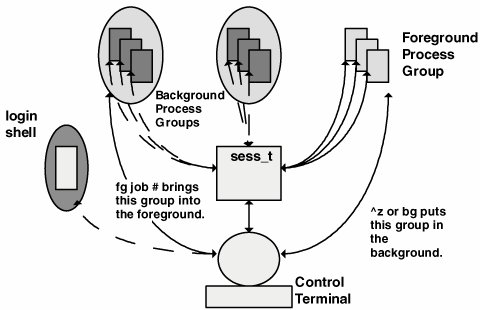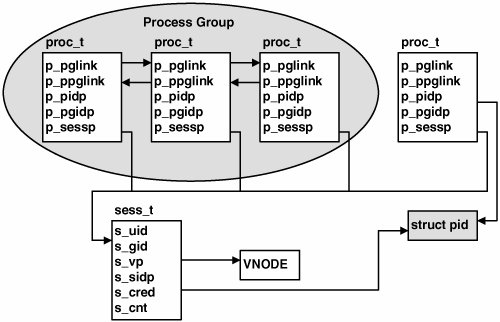Section 2.12. Sessions and Process Groups
2.12. Sessions and Process GroupsThe kernel creates several groupings of processes representing different abstractions by which it manages various aspects of process control. In addition to the family hierarchy of process parent/child, the kernel implements process groups and links processes associated with the same terminal session. Both sessions and process groups are collections of one or more processes that have a common relationship or ancestry. The two abstractions, sessions and process groups, are intimately related to each other and tied closely to the signal and terminal (tty) subsystems. Historically, process groups and sessions arose from the desire to increase the power and flexibility available to UNIX users: developers, systems administrators, and end users. The groups and sessions enable users to run multiple, concurrent jobs from a single login session, to place jobs in the background, bring them into the foreground, suspend and continue jobs, and toggle which job is actively connected to the control terminal (the foreground job). The kernel maintains process groups and session links to establish an event notification chain in support of job control shells. The signal facility starts and stops processes (or jobs in this context), puts processes in the background, and brings them into the foreground. Using the process group linkage makes signal delivery to multiple, related processes much easier to implement. Adding the sessions abstraction puts a boundary between the process group jobs and the interactive login session. Every process belongs to a process group, identified by the p_pgidp pointer in the process structure, and is established in the kernel fork code when the process is created. Thus, processes in the same parent/child/sibling chain, by default belong to the same process group. The process group ID (PGID) is the process PID of the process group leader. That is, every process group has a process group leader whose PID and PGID are the same. Sibling processes are assigned the PGID of the parent process; thus, the PGID of siblings will be the PID of the process group leader. When a stand-alone process is started from a shell, it is placed in its own process group with the setpgid(2) system call, invoked from the shell code after the process is created with fork(2). Processes grouped on a command line (for example, a pipeline) are all part of the same process group. The first process created becomes the process group leader of the new process group, and subsequent processes in the pipeline are added to the group. Here's a quick example. ksh> cat report_file | sort -1 +2 | lp & The shell in the above example is the Korn shell. Three processes are created, one each for cat(1), sort(1), and lp(1), and all are placed in the same process group. That group is put in the background, where the above job crunches away while an interactive user session continues. In this context, a job refers to processes in the same process group working toward a common goal and connected by pipes. The proper job control keystrokes (Control-Z in /bin/ksh) could stop all the processes in the group, sending a SIGTSTP signal to all the processes in the process group. The setpgid(2) system call places the processes in the same process group. Although process groups are most commonly created from the user's shell, an application program can use the setpgid(2) or setpgrp(2) system calls to create new process groups. Process groups can be in the foreground or the background. The foreground process group is the process group that has access to the controlling terminal, meaning that input characters are sent to the foreground process group and output characters (writes to stdout and stderr) are sent to the controlling terminal. Background process groups cannot read from or write to the controlling terminal. An attempt to read from or write to the controlling terminal by a process in a background process group results in a SIGTTIN (read) or SIGTTOU (write) signal from the kernel to the processes in the background process group. The default disposition for these signals is to stop the processes. Processes belonging to the same process group are linked on a doubly linked list by pointers in the process structure: p_pglink (points to the next process in the process group) and p_ppglink (points to the previous process). Figure 2.12 illustrates the process group links and the ID name space links (pointers to the PID structures). Figure 2.12. Process Groups Figure 2.12 illustrates a process as the only member of a process group (upper diagram), and three processes in the same process group (lower diagram). The processes in the lower diagram that are not the process group leader obtain their PGID by linking to the PID structure of the process group leader. Process groups are a subset of sessions; a session has one or more process groups associated with it. A session abstracts a process and the process's control terminal and extends the abstraction to include process groups. All the process groups within a session have a common controlling terminal. Thus, all processes belong to a process group and are associated with a session. Sessions are abstracted by the session data structure, which the process links to through its p_sessp pointer. As with process groups, sessions are inherited through the fork() code. The control terminal is typically the login terminal the user connects to when logging in to a Solaris system. The phrase control terminal is more an abstraction these days (as opposed to an actual, physical terminal) because most login sessions are network based and the terminal is a window on the screen of a workstation, implemented by one of many terminal emulation utilities (xterm, dtterm, shelltool, cmdtool, etc.). Network logins (rlogin(1), telnet(1), etc.) are supported by pseudoterminals, which are software abstractions that provide terminal I/O semantics over a network link or through a window manager running under the X Window System. (X Windows is the network-transparent windowing system that virtually all UNIX vendors on the planet use for their graphical user interface (GUI)-based workstation environments.) A control terminal is associated with a session, and a session can have only one control terminal associated with it. A control terminal can be associated with only one session. We sometimes refer to a session leader, which is the foreground process or process group that has established a connection to the control terminal. The session leader is usually the login shell of the user. The session leader directs certain input sequences (job control keystrokes and commands) from the control terminal to generate signals to process groups in the session associated with the controlling terminal. Every session has a session ID, which is the PGID of the session leader. The session abstraction is implemented as a data structure, the session structure, and some support code in the kernel for creating sessions and managing the control terminal. The session structure includes the following:
The session ID is derived in the same way as the PGID for a process. That is, the session structure links to the PID structure of the process that is attached to the control terminal, the login shell in most cases. Note that daemon processes, which do not have a control terminal, have a NULL vnode pointer in the session structure. All processes thus link to a session structure, but processes without control terminals do not have the vnode link; that is, they have no connection to a control device driver. Figure 2.13 illustrates a broad view, encapsulating a login session (a session) with a shell process in its own process group, plus three additional process groups. One process group is in the foreground, thus attached to the control terminal, receiving characters typed and able to write to the terminal screen. Job control shells use a ^Z (Control-Z) key sequence to place a foreground process/process group in the background. A SIGTSTP signal is sent to all the processes in the group, and the processes are stopped. If a process sets up a signal handler and catches SIGTSTP, the handler is invoked and governs the process behavior. Figure 2.13. Process Groups and Sessions Figure 2.14 shows some details of the data structures and links for a simple case of a login session with two process groups. One process group has only one process, the login shell. The other process group has three processes. They all link to the session structure, which connects to the device and device driver through the s_vp vnode pointer. The session leader is the login shell, and the session ID is the PID of the login shell. Figure 2.14. Process Group and Session Links The session leader (for example, the shell) handles the communication link to the control terminal by using library calls that translate to ioctl() routines into the STREAMS subsystem. (The character device drivers in Solaris for serial terminals and pseudoterminals are STREAMS based.) The standard C library includes tcsetpgrp(3) and tcgetpgrp(3) interfaces for setting and getting the process group ID for a control terminal. When processes or process groups are moved from the background into the foreground, the session leader issues a tcsetpgrp(3) call to direct the control terminal to the new foreground process. The tcsetpgrp(3) call results in an ioctl() call into the tty/pty driver code with the TIOCSPGRP flag, which in turn enters the STREAMS subsystem, calling the strsetpgrp() function (STREAM set process group). The data structures associated with the control terminal include a STREAM header structure, stdata, which contains a pointer to a PID structure for the foreground process group. When a new process or process group is placed into the foreground, the sd_pgidp pointer is set to reference the PID structure of the process group leader in the new foreground process group. In this way, the control terminal is dynamically attached to different process groups running under the same session. The signal mechanism in the kernel that delivers signals to groups of processes is the same code used for other signal delivery. A pgsignal() (process group signal) interface is implemented in the kernel. The function follows the pointers that link processes in a process group and calls the generic sigtoproc() function in each pass through the loop, causing the signal to be posted to each process in the process group. |
EAN: 2147483647
Pages: 244


